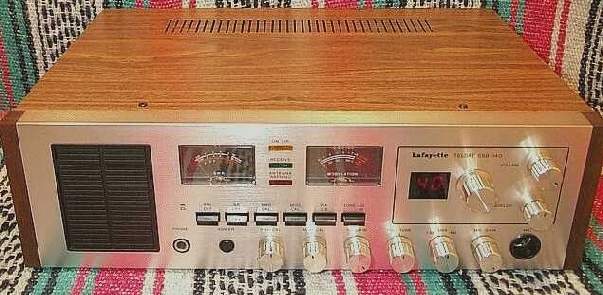

This is the Lafayette Telsat SSB 140. This was Lafayette's deluxe, top-of-the-line 40 channel AM/SSB base station. Showing up on the scene shortly after the 40 channel band plan became legal in 1977, this radio became an instant hit among loyal Lafayette users, and other locals. This radio was equipped with the usual standard features of Volume, Squelch, a 40 channel channel selector with LED display, Mode Switch, and Receive-Only Fine Tune (Clarifier). In addition to these standard controls, there were also both R.F. and Mic Gain controls, SWR and modulation calibration controls, and a row of pushbuttons which included Power, ANL, NB, SWR/CAL, MOD/CAL, PA/CB, and a Hi/Lo tone switch. Rounding out the user features was not one, but two large multi-function meters, which measured S/RF, SWR and Modulation. There were also indicators for receive, transmit, and Antenna Warning (high SWR). A 1/4" headphone jack was included as well. The whole thing was packaged in a nice simulated woodgrain cabinet, which gave it an overall pleasant appearance, similar to Hi-Fi gear of the time. Curiously though, as a base station rig with this many features, it lacked a clock, which was a pretty standard feature for a large deluxe base radio.
Under the hood, this radio was equipped with the same basic radio chassis that could be found in other Lafayette SSB models, as well as models offered by other manufacturers such as General Electric, Hy-Gain, Colt, and others. The biggest attraction of this particular chassis was the inclusion of Cybernet's famous PLL-02a PLL chip. This chip was capable of 512 distinct frequency divisions, of which over 200 could be utilized.
Performance wise, this radio was typical of other Cybernet radios. It lacked microphone pre-amplification stages, and as a result, modulation was a bit anemic on a stock microphone. Users running a pre-amplified mic would need to run it a bit higher than on other radios which included internal mic preamps. But this was not normally a big deal, as most people ran their mic's too far up anyway. Transmit power on SSB pretty much max'ed out at between 15 and 18 watts. AM power was adjustable via a 5 watt rheostat. AM carrier could be set as high as 10 watts, but modulation suffered considerably at that point. The receiver performance was fairly good on both SSB and AM. Sensitivity was good, and adjacent channel rejection was about average for a 40 channel radio. Noise blanker performance was effective. I did not own a 140, but I had the mobile version of it, the SSB-80, so performance characteristics are similar. A few people in the local area owned 140's, including Jungle Jim and Grasshopper.